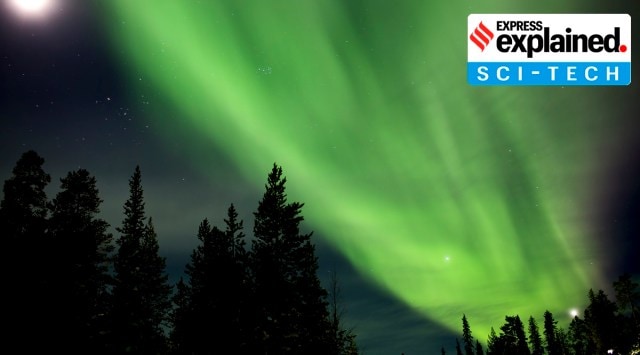- India
- International
Explained: Why parts of the US may be able to see the Northern Lights
The Northern Lights, also known as aurora borealis, are usually witnessed far up in the polar regions or the high latitude regions of Europe. But, on Thursday, they could be visible in parts of Illinois and Pennsylvania in the US.
 The northern lights in Lapland, Finland. (The New York Times: Russ Juskalian, File)
The northern lights in Lapland, Finland. (The New York Times: Russ Juskalian, File) Northern Lights, also known as aurora borealis, are usually witnessed far up in the polar regions or the high latitude regions of Europe, like in Norway. But, on Thursday, they could be visible in regions that are more to the south, such as in the northern parts of Illinois and Pennsylvania in the US.
This is happening due to a solar flare, which emerged from a Sunspot on Monday. The flare is accompanied by a Coronal Mass Ejection (CME) — a large bubble of radiation and particles emitted by the Sun that explodes into space at high speed.
Geomagnetic Storm Watches in effect Dec 9 – 11, 2020, due to anticipated CME effects. The CME occurred on December 7th, and was associated with a C7 flare from Region 2790. For the full story visit https://t.co/mzq8JTer8q @NWS pic.twitter.com/EKOKtiyz3e
— NOAA Space Weather (@NWSSWPC) December 8, 2020
The Space Weather Prediction Center at the US National Oceanic and Atmospheric Administration (NOAA) said the electromagnetic storm could be growing to major status on Thursday, causing the Northern Lights to be visible in more number of areas than usual.
What causes an aurora?
Auroras occur when charged particles ejected from the Sun’s surface — called the solar wind — enter the Earth’s atmosphere. While flowing toward Earth, the fast-moving solar wind carries with it the Sun’s magnetic field, which disrupts the magnetosphere — the region of space around Earth in which the magnetic field of our planet is dominant.
When the Sun’s magnetic field approaches Earth, the protective magnetic field radiating from our planet’s poles deflects the former, thus shielding life on Earth. However, as this happens, the protective fields couple together to form funnels, through which charged solar wind particles are able to stream down to the poles. 📣 Follow Express Explained on Telegram
At the north and south poles, the charged particles interact with different gases in the atmosphere, causing a display of light in the sky. This display, known as an aurora, is seen from the Earth’s high latitude regions (called the auroral oval), and is active all year round.

In the northern part of our globe, the polar lights are called aurora borealis or Northern Lights, and are seen from the US (Alaska), Canada, Iceland, Greenland, Norway, Sweden and Finland. In the south, they are called aurora australis or southern lights, and are visible from high latitudes in Antarctica, Chile, Argentina, New Zealand and Australia.
Generally, the auroral oval is confined to the polar regions. But occasionally, the oval expands, and the lights become visible at lower latitudes, as is expected to happen on Thursday. This happens during periods of high solar activity, such as the arrival of solar storms.
What are the examples of high solar activity?
Solar activities include solar flares, solar energetic particles, high-speed solar wind and Coronal Mass Ejections (CME). These influence the space weather which originates from the Sun.
The NOAA’s Space Weather Prediction Center has forecasted a Level G3 or “strong” storm on our planet on Thursday, making it possible for auroral displays to be visible in relatively lower latitudes, such as in the US cities of Chicago, Detroit, Boston and Seattle.
Thursday’s geomagnetic storm is ranked third on the five-point scale used to measure geomagnetic storms. As per the NOAA, a G3 storm can require voltage corrections to be made in power systems, and false alarms can be triggered on some protection devices. Large storms usually occur at the peak of the 11-year solar cycle, or during the three years after the peak.
Can solar flares or storms be dangerous?
Solar flares can typically affect space-dependent operations like Global Positioning Systems (GPS), radio and satellite communications, besides hampering flight operations, power grids and space exploration programmes.
In 1967, a major solar flare (classified at Level G5) almost led to a nuclear war during the Cold War, as per a Space.com report. In May that year, the US Air Force’s Ballistic Missile Early Warning System radar sites in Alaska, Greenland and the UK got jammed due to the flare, causing US officials to mistakenly hold the Soviet Union responsible for the radar failures. It was only after scientists at the North American Aerospace Defense Command (NORAD) informed US leaders of the solar flare that the matter deescalated.
CMEs pose danger to space weather. Ejections travelling at a speed of 500km/second are common during solar peaks and create disturbances in Earth’s magnetosphere, the protective shield surrounding the planet. At the time of spacewalks, astronauts face a great health risk posed by exposure to solar radiation outside Earth’s protective atmosphere. Such advance predictions are regularly sought out by countries who have made heavy investments in space missions. Besides, the life of functional satellites, and even those which have now turned into debris, depends a lot on the Sun’s activities.
More Explained
EXPRESS OPINION
Apr 26: Latest News
- 01
- 02
- 03
- 04
- 05









































